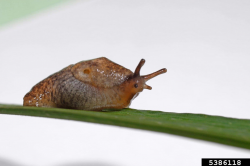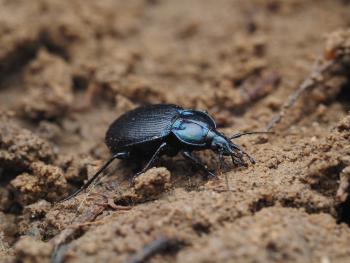Slugs
While they are not typically a major pest in large-scale farms in Massachusetts, slugs may cause significant damage at smaller scales. Cool, wet periods, especially in the spring, and reduced-tillage systems can increase slug pressure on farms.
Life Cycle

 Slugs overwinter as translucent, light-colored eggs in the soil or other sheltered areas. These eggs hatch in the spring, and juveniles begin feeding on any of a wide range of weeds and crops. Slugs are slimy, soft-bodied invertebrates with two pairs of appendages at the head: one larger pair with eyes and a smaller pair underneath used for identifying odors, similar to the antennae of insects. They are close relatives of snails but are more frequently damaging to crops. Slugs may range in body size from 1/4” to over 4” long depending on age and species. There are many common slug species that may be pests in New England including the gray garden slug, banded slug, marsh slug, and spotted garden slug, but management does not vary considerably between different species. They are typically tan to grayish brown or black and may be patterned with spots or stripes along their body.
Slugs overwinter as translucent, light-colored eggs in the soil or other sheltered areas. These eggs hatch in the spring, and juveniles begin feeding on any of a wide range of weeds and crops. Slugs are slimy, soft-bodied invertebrates with two pairs of appendages at the head: one larger pair with eyes and a smaller pair underneath used for identifying odors, similar to the antennae of insects. They are close relatives of snails but are more frequently damaging to crops. Slugs may range in body size from 1/4” to over 4” long depending on age and species. There are many common slug species that may be pests in New England including the gray garden slug, banded slug, marsh slug, and spotted garden slug, but management does not vary considerably between different species. They are typically tan to grayish brown or black and may be patterned with spots or stripes along their body.
Most slugs reach maturity in 3-6 months. Slugs are hermaphroditic with all individuals capable of laying eggs, which occurs several times per year. Generations overlap and all life stages may be present and feeding through the summer and fall.
Damage

 Slugs are generalists, feeding on a wide variety of crops and plant parts including roots, leaves, stems, and fruits. Damage usually appears as large, ragged holes in leaves, but may also include shallow holes in fruits such as tomatoes, peppers, and strawberries. They use their chewing and rasping mouthparts to completely consume large portions of leaves, as opposed to caterpillars which can cause similar feeding damage but avoid consuming leaf veins and stems. Although low to moderate levels of slug damage are not significantly detrimental to plant health, heavy feeding can cause injury and mortality in seedlings and affect development and yield in larger plants, and feeding damage on fruits and leafy greens renders crops unmarketable.
Slugs are generalists, feeding on a wide variety of crops and plant parts including roots, leaves, stems, and fruits. Damage usually appears as large, ragged holes in leaves, but may also include shallow holes in fruits such as tomatoes, peppers, and strawberries. They use their chewing and rasping mouthparts to completely consume large portions of leaves, as opposed to caterpillars which can cause similar feeding damage but avoid consuming leaf veins and stems. Although low to moderate levels of slug damage are not significantly detrimental to plant health, heavy feeding can cause injury and mortality in seedlings and affect development and yield in larger plants, and feeding damage on fruits and leafy greens renders crops unmarketable.
Scouting
Slugs can be difficult to find as they are nocturnal, coming out to feed at night when conditions are cool and damp, then hiding away under weeds, rocks, and debris during the day. Inspect plants for characteristic signs of slug damage as well as shiny trails of mucus, which they leave behind. There are no established thresholds for treatment. Slugs can also be found by scouting at night with a flashlight or by placing large flat objects such as stones or shingles over 6”-deep holes where slugs are suspected to be active. These objects can be lifted up during the day to reveal any slugs which have taken shelter underneath them.
Management
Cultural Controls
- Tillage or similar soil disruption early in the season can destroy slugs and eggs, but farms that have adopted reduced-tillage systems may require other forms of management.
- Avoid moist, shaded habitats near crops. Eliminating weeds can reduce slug habitat.
- Hand picking. At small scales, slugs can be hand-picked with gloves and dropped into soapy water. This should be done early in the morning or after dusk while slugs are most active. Repeat for several days until slug numbers are reduced.
- Beer traps can be used to attract and drown slugs. Bury a container 6” deep in the soil such that the top of the container is flush with the soil’s surface. Fill the container with beer or a mixture of water and yeast to attract slugs, which fall into the liquid and drown. Check, clean, and refill traps as needed every 2-3 days.
- Barriers such as copper tape or foil placed around crops can deter slugs by reacting with their mucus and disrupting their nervous systems. However, these barriers are not always effective and are more practical at small scales where crops can be entirely surrounded. Diatomaceous earth is a powdery substance that can also be used as a pest barrier in some cases. It is sharp on a microscopic scale and can injure many arthropods by cutting their cuticles, but loses efficacy when wet, making it ineffective in the damp conditions preferred by slugs.
Biological Control
 Some predaceous beetles such as ground beetles, rove beetles, and firefly larvae are common and regularly feed on slugs and snails as well as other soft-bodied pests. Like slugs, many of these beetles are primarily nocturnal and become more active at night. Although sheltered areas near crops can harbor slugs, once established, these habitats also become populated by naturally occurring predators which can keep slugs at manageable levels. Grassy field boundaries called beetle banks can be created to provide sheltered habitat for these beneficial predators on farms, increasing their numbers. Increased crop diversity, use of cover crops, and reduced use of broad-spectrum insecticides can also help to conserve these natural enemies.
Some predaceous beetles such as ground beetles, rove beetles, and firefly larvae are common and regularly feed on slugs and snails as well as other soft-bodied pests. Like slugs, many of these beetles are primarily nocturnal and become more active at night. Although sheltered areas near crops can harbor slugs, once established, these habitats also become populated by naturally occurring predators which can keep slugs at manageable levels. Grassy field boundaries called beetle banks can be created to provide sheltered habitat for these beneficial predators on farms, increasing their numbers. Increased crop diversity, use of cover crops, and reduced use of broad-spectrum insecticides can also help to conserve these natural enemies.
Chemical Control
Slug baits such as iron phosphate (Sluggo) and metaldehyde (Deadline) pellets contain substances that harm the digestive system of slugs and snails. Both are applied as soil surface treatments and should not be applied to edible portions of plants. Iron phosphate pellets (Sluggo) are OMRI-listed and effective at small scales but can be costly at large scales. However, iron phosphate is relatively specific in its toxicity to slugs and snails, reducing the impact on natural enemies that can help to control these pests. See the appropriate crop insect control section of the New England Vegetable Management Guide for more information on slug control.
Additional Resources
- Managing Earwigs & Slugs - UMass Extension
- Slugs as Pests of Field Crops - PennState Extension
The Center for Agriculture, Food and the Environment and UMass Extension are equal opportunity providers and employers, United States Department of Agriculture cooperating. Contact your local Extension office for information on disability accommodations. Contact the State Center Director’s Office if you have concerns related to discrimination, 413-545-4800 or see ag.umass.edu/civil-rights-information.